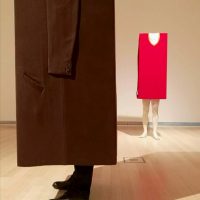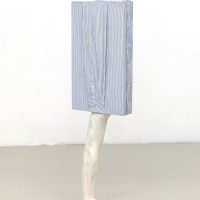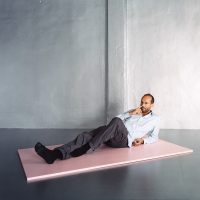Physical Exercises, 2003., mixed technique, (Performed by the Artist) Biennale d’Art Contemporain de Lyon, France, 2005, Photo: Christoph Maout, Paris
Wurm’s first large-scale exhibition in Budapest features a comprehensive selection of his conceptually distinct series of sculptures and creations. Besides his photo- and video-based works, his transmogrified furniture-sculptures, clothing and performative sculptures, but also his artistic wallpapers and drawings will be put on display.
Erwin Wurm is perhaps the most famous figure of Austrian contemporary art. Initially, he made colourful, expressive wooden sculptures, then minimalist compositions out of metal pots. Meanwhile, he was constantly seeking new sculptural possibilities and extremes. He viewed the depressing weight and empty pathos of traditional metal and stone sculpture with a critical attitude not devoid of irony.
Expanding the sphere of materials that could potentially express meaning with a technical angle, he turned to non-traditional sculptural materials, experimenting with textile, paper and plastics. Part of his works in the late ‘80s feature clothes as sculptures. Wurm subverted the original context of textiles: no longer objects in his works, they hung like pictures on walls, or gained a sculptural character as a result of special folding.
Objects accompanied by instructional texts and figures had already emerged in his oeuvre around this time: visitors had to first wear his clothes and then carefully fold them and place them tightly in a box. The active involvement of the spectator in the creative process was a development that would define the spirit of Wurm’s subsequent work.
In Wurm’s conception, sculpture is not a solitary thing, an end in itself, but the product of a creative process, an appropriately chosen and frozen moment, a creative act that can be executed by anyone who knows the idea. To Wurm, even the occasion of presenting artworks, the exhibition, is not a situation, but a call to create and document carefully pre-planned works.
The separation of sculpture as a possibility from the artist and the creative process is an underlying trait of his works. In addition, his interest in the quotidian and banal, its emphasis, enlargement and totalisation, is a cultural practice not uncommon in the Austrian tradition, if we just think of Freud and Wittgenstein.
The other important discourse he joins is the evolution of modern sculpture in the history of 20th century art as well as the problem of contemporary sculpture. Wurm transcends the notion of modern and avant-garde sculpture in a way that he condenses the essence of sculpture into an aspect of its creation. He creates, or more precisely, outlines de-heroicised sculptural situations, and then has the spectator carry out their execution.
His series of One Minute Sculptures evolved in the ‘90s from the late ‘80s conceptual sphere. This type of artworks emerged formally from 1997: situational exercises during which the human body interacts with everyday objects or other bodies, and which are expressed and visible only temporarily, before disintegrating as the spectator gets tired.
Most of Wurm’s One Minutes are funny situations, but also seriously challenging physical exercises. With the sculpture being carried out by the spectator based on instructions, the artist accurately demonstrates that before being realised physically, in terms of origin, no sculpture is more than a mental image in our head.


